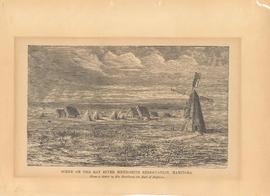This photo is of a sketch done by the Earl of Dufferin, 3rd governor General of Canada on his visit to the Mennonite East Reserve in Manitoba in 1878. Published in Mennonite Historian Vol. XXIV, #1, March 1998, p.6. acc#00-132 cop. 2. See textual collection 5691:8 for information about Dufferein's visit submitted by William Schroeder. (2013-066)
In 2011 acc # 2011-075 we received "Scene on the Rat River Mennonite Reservation, Manitoba. From a sketch by his excellency the Earl of Dufferin. Etching signed by M.L, Toronto Eng. Co. (Toronto Engraving Company) . -- Note: this is a page from a book. -- copy 2. -- Note: included are three copies of publications where this image has been used and which include other information about the owners of the buildings.
Educator and historian William Schroeder in the June Mennonite Historian" writes regarding this image: Dear Editor:
Jacob Dick's purchase of an engraving in an Ottawa flea market provides additional visual information about the Mennonite settlements at an early period. The engraving, based on a sketch done by Lord Dufferin during his visit to the Rat River (East) Reserve in 1877, is the only known pictorial record of Lord Dufferin' s visit to the Mennonite settlement. A professional photographer had located in
Fort Garry during the 1860s and was on hand in 1873 when the Mennonite delegates departed for their tour and inspection of the East Reserve. He also recorded for posterity the arrival of the first contingent of Mennonites on the International in 1874. However, there are no photographs of the Governor General's visit to the East Reserve in 1877. Fortunately, Frederick T . Blackwood (Lord Dufferin) was an artist. Lady Dufferin wrote in her diary, " 'D' drew a good deal and finished some very nice sketches."
The scene in the engraving is the village of Eigenhof on August 21, 1877. The village had only two farmyards. The house-barn on the left belonged to Jacob Wieler and the one on the right belonged
to Gerhard Schroeder. The vice-regal couple, their daughter Nellie, and their entourage slept in the three circular tents. The cook prepared the food in the rectangular tent. The formal reception was
held on a shaded platform just off to the left of the picture. A German and British flag few on each side above the decorated arbour. The windmill depicted in the engraving was built by Gerhard Schroeder. The details that Dufferin included in his sketch of that landmark indicates that he appreciated the skill of the Mennonite millwright who, with the simplest of tools and materials, had created a machine that
could harness the wind's energy. The walls and frame of the octagonal tower were made from tree trunks, and the arms of the sails were held in place by ropes. This information was provided by the
late Abram P. Dueck of Randolph (Chortitz), Manitoba, a great- grandson of Gerhard Schroeder. A.P. Dueck heard the story of the visit of Lord Dufferin from his grandfather, Rev. Johann Schroeder,
who was five years old when the visit occurred. A map based on A.P. Dueck's information was made by William Schroeder in 1978, and shows an almost identical placement of the tents and buildings as is shown in the engraving. This memorable occasion was described briefly years later by several Mennonite pioneers in a local publication and at length in the Manitoba Free Press . The Countess of Dufferin (Harriot Hamilton, 1839-1936) described this visit in detail in a letter she wrote to her bedridden mother in Ireland. A longer and more detailed account of this visit is included on pages
95- 109 in The Bergthal Colony by William Schroeder.


